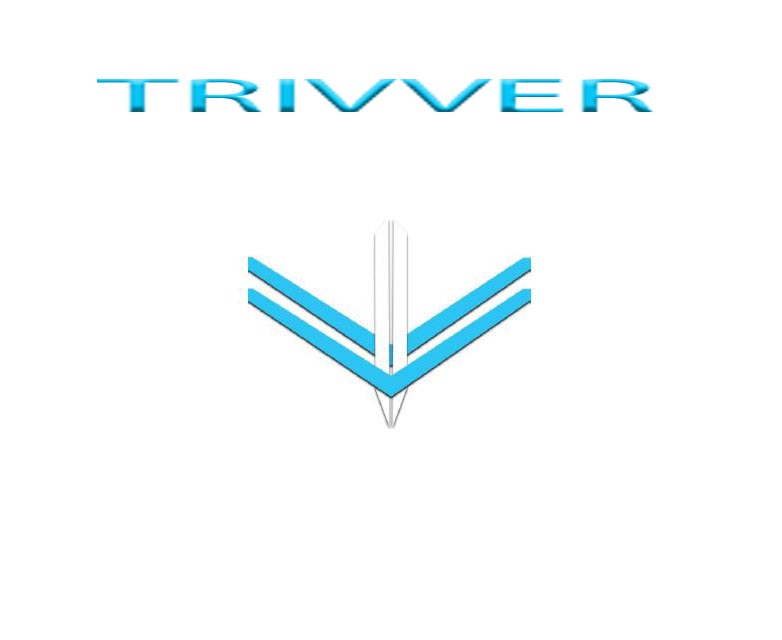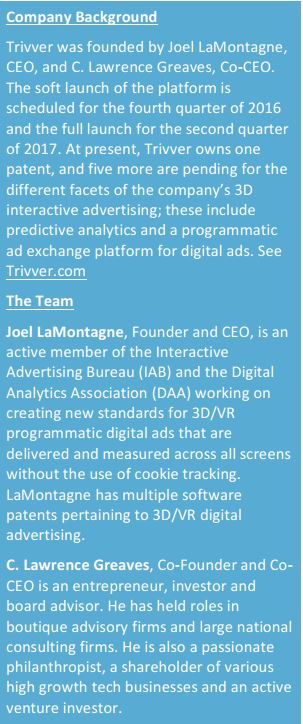
Web Developers
We recently had a conference call with Joel LaMontagne, the founder of Trivver. The company is building a technology that allows brands to bid for advertising opportunities and advertise their products on multiple 3D and 2D digital platforms, such as mobile, web, virtual reality (VR) and augmented reality (AR) platforms. In this report, we discuss how brands will advertise in the future and how Trivver’s technology will help them capture the market.
Juniper Research estimates that the total value of digital advertising revenue will double by 2020, reaching $285 billion, with a growing programmatic channel within digital. Magna Global forecasts that programmatic advertising alone will generate $32 billion in revenue in 2017. While companies are clearly devoting more dollars to digital marketing, they are currently mostly investing in 2D environments through the Google and Facebook platforms. Combined, these two platforms accounted for 75% of all new online ad spending in 2015, according to Mary Meeker’s 2016 Internet Trends report. Yet neither Google nor Facebook has released a solution for adverting in 3D environments, such as VR and AR, and the question for brands is how they can leverage the growth of 3D media.
Bidding: Digital publishers list their 3D generic content to be replaced by branded items on the ad exchange, and brands then bid on the advertising opportunity.
Product placement: The product is displayed in the immersive environment and appears in the consumer’s smart tab, an interactive screen that houses content all brands have placed in the viewer’s environment. The smart tab allows the consumer to learn more about a brand, download discount coupons and see shop locations; the information is presented in a non-intrusive way.
Targeting and predictive analytics: Advertisers use analytics to better target their audience, putting the ads that are most applicable in front the consumer, based on that consumer’s actions, in real time. Advertisers are provided with analytics reports on viewability metrics, user engagement metrics and user data (behavioral patterns and psychographic and demographic information). The information can be used to create an even more personalized experience for the consumer.
Trivver provides benefits for various players across the value chain:
MARKET POTENTIAL
THE CHALLENGE
Because 3D environments are immersive, there is a problem with using traditional digital advertising methods, such as pop-up ads, within them: these kinds of ads are too intrusive for the consumer/user. Apple has rejected disruptive ads for precisely this reason. So, 3D advertising will likely evolve into the placement, within VR, of branded objects that become native to the user’s environment. These placed objects will function much like product placements in movies do. The challenge is that this type of advertising is very costly, as ads need to be developed for each individual application. So, 3D advertisers will not be able to enjoy the same cross-platform reach that can currently be achieved through programmatic ads.TRIVVER’S SOLUTION
Trivver’s value proposition is to solve the challenges associated with 3D advertising by creating a standard way for companies to advertise across any digital environment. The company has developed 3D, interactive smart objects that can be placed into online games, VR Real Estate, VR Stores, digital videos, digital TV content or mobile apps. These smart objects can be branded products or engagement items. The company has also created an ad exchange that allows advertisers and developers to trade these smart objects and a user app, the Trivver app, which allows the consumer to store, navigate and manage ad content. Behind the scenes, Trivver’s technology personalizes apps and gaming environments with branded objects that are relevant to the consumer, while providing real-time analytics on metrics such as engagement and conversion to the client. For companies, the experience of advertising via Trivver will be similar to buying and selling ads on some of the existing bidding platforms. But for the consumers, the experience will be completely different as it will knock down existing silos. They will be able to see products of interest to them across applications and platforms and in immersive environments.HOW IT WORKS FOR BRANDS
Below, we outline the process for brands to leverage Trivver’s 3D advertising solution in order to better target the end market.- Brands and advertisers: Advertisers are able to target consumers on various channels and devices through Trivver. Advertisers will likely benefit from higher ROI on ad spend, driven by better analytics and personalization and by broader reach with omni-channel advertising.
- Users: Consumers can engage with, bookmark, tweet, share, “like” and buy their favorite brands. As Trivver operates under the principle of unobtrusive advertising, consumers are not presented with ads that are irrelevant to them, resulting in a more personalized experience.
- App and game developers: Developers benefit from higher ad revenue via multiple touch points. Through Trivver, smart objects can be placed within numerous environments to reach a mass, targeted audience, which is conducive to increased monetization. Trivver’s ability to place branded objects in multiple environments enables even small game developers to monetize their offerings.
- Digital advertising industry: Trivver is creating new standards for 3D ad content in digital advertising, expanding the industry’s reach and impact.

